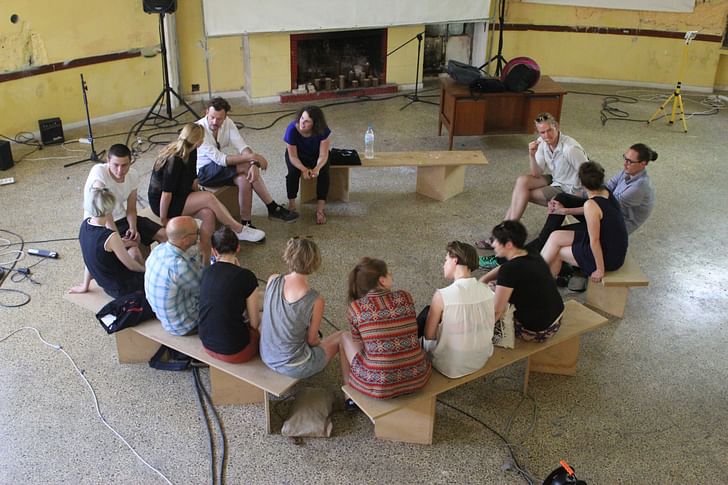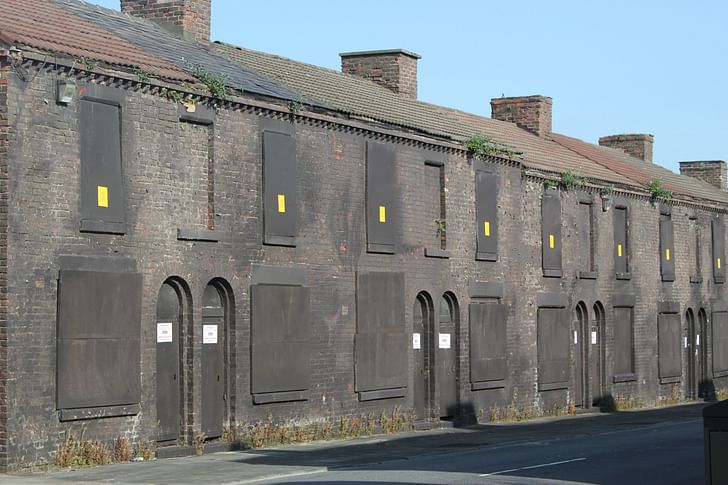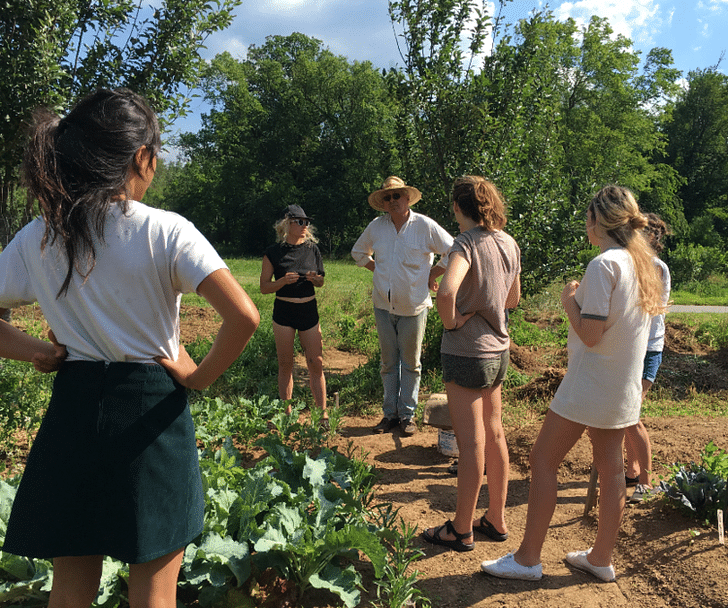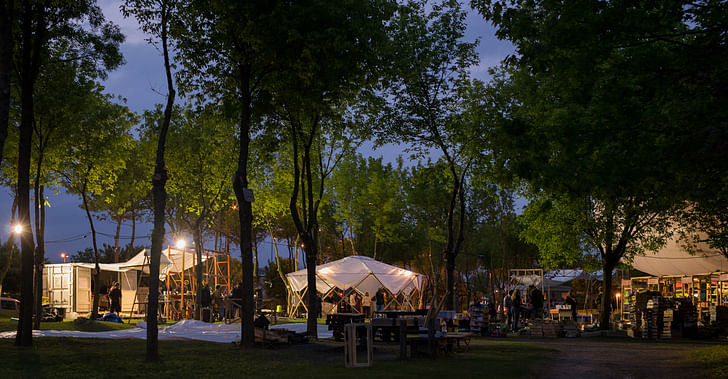

Over the course of the last few years, debate around the form of architectural education has reached new levels of popularity, illustrated by the proliferation of reflexive initiatives, conferences and publications around artistic and architectural education as well as through the emergence of new experimental models.
Nevertheless, if few alternative solutions pop up around the world, it is largely because there is no common understanding of the actual issues architectural education is facing globally. The challenges undertaken today by students enrolled in architectural academia vary tremendously from one country to another. On the one hand, Anglo-Saxon researchers and critics point to the rise of tuition fees and the exclusive and non-integrative access to academic education—transforming any architect-to-be into highly indebted citizens before they start to generate income. On the other hand, Europeans, mostly benefitting from free educations, would target the difficulty for academia to cope with evolving contemporary practices and to incorporate physical and socio-economic realities into the curriculum.
According to Beatriz Colomina, commenting on her project Radical Pedagogies in the Architectural Review, “Curricular structures have hardly changed in recent decades, despite the major transformations that have taken place with the growth of globalization, new technologies, and information culture. As schools appear to increasingly favor professionalization, they seem to drown in self-imposed bureaucratic oversight, suffocating any possibility for the emergence of experimental practices and failures. There are a few attempts to wake things up here and there but it’s all so timid in the end. There is no real innovation.”
So what is the problem?

The problem is the structure
In fact, the mission statements of architectural educational institutions are far from being consensual and differ not only according to national borders but also from one university to another. The necessity for universities to behave as competitive entities has progressively transformed the educational panorama, instating evaluations based on ranking and reputation within an entrepreneurial reality. Naturally, the financing apparatus behind educational institutions, often composed of both public and private sources, influences the tenure of the content and the pedagogical curriculum; today’s educational institutions are companies like any other, relying on results and profitability rather than experience and creativity. This competitive aspect of educational institutions is passed on to the other hierarchical levels: students are competing against each other to preclude the possibility of failure, and the competition even extends to the professors and teaching bodies whose academic projects’ existence also depends on external and additional funding. As such, pedagogic initiatives are intrinsically linked to the political agenda and necessarily intervene within certain circles of influence and power. The conflicts emerging from the professors’ fights for survival tend to divide the pedagogical units into separate clans, reducing possibilities for collaboration and damaging the global vision and overview of a pedagogical program within a school or university.

The problem is the goal
Moreover, a fundamental difference divides the architectural educational scene: whereas some schools focus on teaching architecture, others propose to train architects. If there is no common understanding of what architecture is and encompasses, the same observation applies to the definition of architect, enriched by the current diversification of practices. Is architecture a language, a tool, a process, a built result, a capacity to organize in space complex data, an act socially and politically engaged? All of that?
If the results of those dogmatic pedagogic positions are observed within the practices of recently-graduated students, they are already present in expectations for attending students: within my personal experience in the Architecture School of Toulouse in France questioning a group of twenty students in their second year of studies, four students claimed to have chosen architecture for the love of construction sites and the management of teams, workers and partners; two considered architecture the means to access a certain social status; and fourteen others remained undefined regarding their future practice, pointing to the wide range of their interests and their freedom to wait and see. Not yet knowing how exactly, they are determined to eventually incorporate those interests into their future practice.Most of the students finish their studies without having ever experimented with the full reality of an architectural project
Those last fourteen approach architecture studies as a possibility to theoretically and empirically explore a variety of disciplines through the filter of architecture. They trust the timeframe of studies—usually long—to help them define their future professional path. Nevertheless, if each student’s path is unique, the diploma they obtain is generic. Graduated students’ capabilities and experiences are in fact expressed through the nature and quality of projects they develop within their studies, not necessarily with the diploma and title they obtain. The same observation applies to the identity of the professors crossing a student’s route: through belonging to specific studios, a possible employer would apprehend the qualities of a young professional as well as their doctrinal direction, no matter how the student positions themself in regards to their professor’s ideas. Of course, on the one hand and especially within the American ecosystem, the recognition of a diploma sometimes benefits from the specialization or the reputation of a University, hence becoming more valuable. On the other hand, seen from a European perspective, where most countries offer studies for free or at low-costs, a French diploma equals a German diploma equals a Spanish diploma. Whereas the portfolio often succeeds in communicating the achievements and orientations of a student, one should question the role of a diploma if it is no longer sufficient to express the resulting skills of a candidate. In some cases, the diploma becomes a pass for the right to practice, serving more the interests of the corporate profession than defining the abilities and talents of young professionals.
In fact, the increase in the regulation and normalization of architectural processes progressively orients studies towards creating professionals able to operate in a regulated local market. As a result, the traditional studio-based teaching and the acceleration of studies towards professionalization might reverse the proportion of determined/undetermined students and progressively constrain the creative scope of the most hopeful and open-minded ones. According to Buckminster Fuller, “What usually happens in the educational process is that the faculties are dulled, overloaded, stuffed and paralyzed so that by the time most people are mature, they have lost their innate capabilities.”
The problem is the distance from reality
Whereas architecture is, in some ways, a concrete discipline, the most commonly observed frustration among students who have completed their studies lies in the abstraction of the projects they develop. That is to say, despite the growing number of design/build architectural studios within universities—which remain a tiny minority—most of the students finish their studies without having ever experimented with the full reality of an architectural project. Absent from the traditional pedagogical curriculum, students do not experience the necessary confrontation with clients and local communities, the administrative and regulative duties, the construction and completion site. Their appetite for action and their need for experimentation—to confirm or infirm the validity of a project on a trial-and-error basis—is illustrated through the growing engagement of self-organized networks of students, such as the European Architecture Students Assembly EASA or Bellastock, for the realization of temporary structures, events and architectural experiments.
Already in 1970, Ivan Illich in his essay Deschooling Society claims that “universal education through schooling is not feasible”. According to him, “It would be no more feasible if it were attempted by means of alternative institutions built on the style of present schools.” He further determines that educational structures shall be thought of in terms of organic webs instead of centralized institutions, giving oneself the opportunity to transform each moment of living into a moment of learning, sharing and caring. In other words, Illich’s educational prescription is based on present experience and peer-to-peer exchanges rather than hierarchical structures and expected results.

Alternatives today for a school of tomorrow
Therefore, it is no surprise that within this educational ecosystem, the number of voices developing alternative paths is rising. Alternative pedagogical theories from the beginning of the 20th century are revived and reinterpreted to fit the information and network era. For example, Finland is on the verge of abolishing disciplines, ranks and levels, and applying John Dewey’s progressive education theories on a national scale for all high schoolers From alternative to the future normal, the three following examples illustrate several interesting orientations regarding the future of educational landscapes in arts, architecture and the city.
Another Black Mountain
Last year, the Black Mountain College campus once again opened its doors under the name of Black Mountain School—now newly renamed the School of the Alternative. The ambition is to restore and experiment with Black Mountain College’s educational principles, including non-accreditation, peer-to-peer learning, communal living and learning based on oneself personal interests. The new school defines itself as an experiment in education and community that supports a collectively-built and self-directed approach to learning. Although the influence of the original Black Mountain College in the field of architecture is well recognized today, architecture was in fact not part of the original pedagogical program – and the same observation applies to Walter Gropius’s Bauhaus. In both of those schools, architecture appeared in the curriculum only to fulfill a spatial necessity: to allocate students and faculty in one dedicated space, suiting their pedagogical values. Nevertheless, the presence of influential individuals such as Buckminster Fuller or the Albers couple contributed to the spread of new architectural thinking.The financial and pedagogical independence manifests in an extreme reactivity and flexibility in internal organization
One of the most fascinating aspects of the Black Mountain example, both at the beginning of the 20th century and now, lies in its governance system. As illustrated by Alexander S. Neill’s free and democratic school model, the school is democratically-run by its participants through regular meetings where all members of the community discuss both community issues and pedagogic questions, without any differentiation or hierarchy between students and faculty members. As at its predecessor, the School of the Alternative is a non-accredited and privately financed institution. It owes its existence to private (crowd) funding, tuition fees and voluntary work—as well as trying to reduce the functioning costs to the minimum. Both old and new non-institutions rely on individuals and on the quality and engagement of the community members, whose first motivation is to share knowledge in a non-linear fashion. The financial and pedagogical independence manifests in an extreme reactivity and flexibility in internal organization as well as in terms of the nature of knowledge exchanged. When most agree that something does not work, that something is simply changed. Also, if architecture is not among the interests listed by students, architecture might not be taught. No problem.
Contrary to the original school, the School of the Alternative happens nowadays only as summer schools, limiting the extent of the experimentation.

The Spaceless School
On the other side of the Atlantic, the Urban School Ruhr, part of the open Raumlabor University and developed in collaboration with Urbane Künste Ruhr, started in 2016 as a learning platform and pedagogic experiment that investigates participative and artistic practices in urban space. The Urban School Ruhr connects individuals with matching interests. Its program develops through nomadic, curated experiences in different cities in Europe—Paris, Marseille, Athens and Liverpool for its first iteration—where participants meet local actors involved in city development and (counter)culture, in cities where the urban environment is visibly shaped by current or recent socio-political factors. The tangible results of such experiments are invisible though, arguably, highly valuable: the network of ideas and influences acquired through displacement travels back with the participants to their original region in Germany, thus engaging the future of the Ruhr area with a new set of inspiration. Students, as future local actors, become the vehicle of ideas for a change.The tangible results of such experiments are invisible though, arguably, highly valuable
Comparable to the future plans announced by Peter Zellner for its Free School of Architecture, due to open in summer 2017, the Urban School Ruhr bet on the long-term outcome of experience-based knowledge. By deciding that there are no produced goals—withdrawing from the temptation to show shiny images of experimental built architecture— they provide an environment for critical thinking and the free flow of ideas. The quality of content the participants incorporate is by nature personal and varies from one participant to another, according to their participatory engagement and to the different encounters and conversations one has had through the course. In fact, by observing the human interactions within the multiplicity of school spaces and rhythms, one can foresee clusters of interests forming naturally and the possible future collaborations emerging from ideological communion, motivation, opportunity to act as well as from the very simple idea of friendship. Only then, by giving those collaborations time to develop, the educational influence of the Urban School Ruhr can be measured.
Everything is in the net?
While we may learn better from direct interaction, the possibilities enabled by contemporary digital tools provide a new field for experimentation. Naturally, architecture needs materials, physicality and spaces, but the Internet allows global networks to form. Such is the case of the Civicwise community and its Civic Design Academy. Situated somewhere between architecture and urbanism with a social turn, its founder, Domenico Di Siena defines Civic Design as a new discipline inherent to the development of urban environment through participatory processes. In that context, the related academy provides digital resources and distant encounters to dig into the notion of Civic Design, its references, as well as tools for its community to build up projects on a local scale with the help and skills of the network members. The question of the governance and legal entity of the community is constantly discussed among the members through a dedicated forum and a Slack channel, a Google drive and set of online videos. Documents are open to all the members of the community, creating an evolving database for the future generations of members.
Those examples, all experimental, open the door to more to come. If they differ in methodological and pedagogical approach, all three rely on the self-motivation of the participants, on the respect and value of their personal interests and ideas and on self-governance. Naturally, if one engages voluntarily in learning, the task becomes suddenly easier— long-lasting results observed in alternative schools where teachers act as moderators show the efficiency of a learning system based on self-motivation. There, to reference the philosopher Jacques Rancière, the ignorant schoolmaster guides learning sessions according to one’s own interests, instead of forcing students into mandatory dedicated disciplines. Those alternative principles even start spreading around the official curricula: pioneering in education standards, Finland’s educational reform adopts co-teaching and project-based learning as the new normal in high schools. By implying that students, participants or citizen are the best ones to evaluate their own experience, those schools provide non-judgmental environments, authorize failure as a productive and necessary means to learn, and free the individuals from the competitive, economical and structural pressure of the normative academic field. Maybe it is time to think of education as a moving framework that has the capacity to easily reinvent itself without endangering its structure. Maybe a school should be where one is free to question rather than obliged to repeat. In that way, those experiments serve as a solid base to build upon a new reflection on the future of architectural education and moreover, on education at large.
Joanne Pouzenc is a French architect and urban explorer who found an urban refuge in Berlin. She tries to escape from her beloved architectural fate by diversifying her centers of interests and offering her views on the contemporary urban conditions via designing, curating, writing ...
3 Comments
I wonder who is the target of these continual attacks on existing architecture schools?
If the "new" schools are so great, go ahead and say what's great about them, instead of casting aspersions in the form of negative stereotypes and hostile generalizations.
Universities are comprised of many diverse people, many of which are in fact excellent at what they do: teach, research, and serve the public need for quality higher education.
I agree we should make Universities free, but this has to do with tax policy and legislation, not with supposedly evil academics.
Want to change the way public Universities are funded? Run for office.
Want to push your university toward excellence? Do great work, apply for job, join the union, fight for academic freedom, continue to great work, and get tenure.
"Alternative Schools" is misleading because I see a great diversity of pedagogies at every school. This is almost like Rorty's call for an end to philosophy itself. Moving beyond this pessimism, there is always cognitive progress at every level from the most restrictive to the most liberal education (Weber is relevant here when he says the German boy learns more than an American one). What I see in the article are current pathologies affecting architecture education.
The Escuela de Arquitectura y Diseño in Valparaiso (Chile) is an other great example of counter education in the architecture field, promoting togetherness, hands on work and poetry.
Block this user
Are you sure you want to block this user and hide all related comments throughout the site?
Archinect
This is your first comment on Archinect. Your comment will be visible once approved.